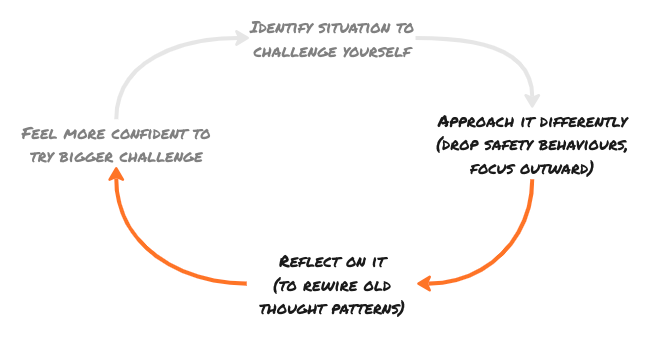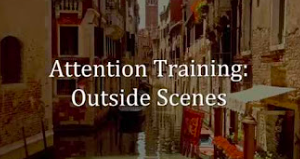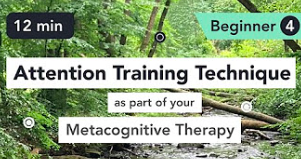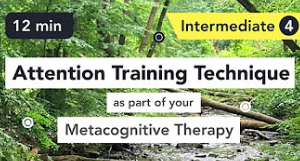Approaching situations differently
In this guide we’ll be looking at the next parts of the loop as explained in part one of this guide – approaching situations differently and reflecting on them in a way that is designed to rewire old thought patterns.

The key to overcoming social anxiety lies in two crucial steps:
- Dropping safety behaviours: These are the actions we take to avoid or minimise anxiety in social situations. Examples include avoiding eye contact, rehearsing conversations beforehand or staying on the sidelines at gatherings. While safety behaviours may provide temporary relief, they ultimately reinforce our fears and prevent us from gaining confidence in our ability to handle social interactions.
- Focusing outward: This involves shifting our attention away from ourselves and our own anxieties and towards others and the present moment. By paying attention to the people we are interacting with and the conversation at hand, we can reduce self-consciousness and engage more fully in social situations.
The core of growth lies in challenging ourselves to try things differently. By stepping outside of our comfort zones and experimenting with new behaviours, we can gain new insights into our own patterns and reactions. As we do this, it is important to approach our experiences with open curiosity, recording our observations without judgement.
In a way we become scientists conducting experiments in the laboratory of our own lives. By carefully observing the results of our actions, we can learn to identify which behaviours are helpful and which are not. Over time, this process of experimentation and learning can lead to significant reductions in social anxiety.
The challenge template, along with the additional exercises below, demonstrates what happens when you drop safety behaviours and focus outward. As you engage in these activities, remember to approach them with a spirit of curiosity and openness. The more you are willing to experiment, the more you will learn about yourself and your social anxiety.
A final word before experimenting yourself – use your WalkTheTalk group as a practice ground and go at a pace that feels right to you.
Follow these guides to understand and get ideas to bring to life your safety behaviours, practice focusing outwardly and see what happens. Your group can be a safe place to practice.
Dropping safety behaviours
What are safety behaviours in social anxiety?
Safety behaviours are actions that people with social anxiety use to avoid or reduce the perceived negative consequences of social situations. They can be subtle or overt and while they can feel helpful in the short term they can maintain and worsen social anxiety in the long term.
Some common examples of safety behaviours in social anxiety include:
- Avoiding eye contact
- Speaking softly or quickly
- Overpreparing for social situations
- Avoiding certain topics of conversation
- Diverting attention away from yourself
- Not saying anything in a meeting or conversation because you think you have nothing to offer
- Leaving social situations early
- Drinking alcohol before social situations
- Relying on friends or family members to support them in social situations

Safety behaviours can be helpful in the short term because they can reduce anxiety and make social situations more bearable. However, in the long term, safety behaviours can actually make social anxiety worse. This is because safety behaviours reinforce the negative thoughts and beliefs that we have about ourselves and social situations.
For example, we may avoid eye contact because we believe that others will judge us negatively. This actually reinforces the belief that we are inadequate and unlikeable. The more we avoid eye contact, the more we’ll believe that we’re right.
Over time, safety behaviours can make it difficult or feel impossible for people with social anxiety to engage in the social situations that they need to in order to live a full and meaningful life. For example, someone who avoids giving presentations at work may miss out on opportunities for promotion. Or, a person with social anxiety who avoids social gatherings may have difficulty making friends and maintaining relationships.
Outward attention in social anxiety
What is focusing outward attention?
Focusing outward attention in social settings means paying attention to the people around you and the environment, rather than focusing on yourself and your anxiety. It’s a skill to learn.
Training outward focus attention is an important part of managing social anxiety. When we have social anxiety, we tend to focus inward on ourselves, our thoughts, and our feelings. This can lead to negative rumination and self-criticism, which can make our anxiety worse.
Training outward focus attention can help us to break this cycle. By focusing on the external world, we can take our minds off of ourselves and our anxiety. This can help us to feel more relaxed and comfortable in social situations.
How do you focus outwardly in social situations?
You can also practice training outward focus attention in everyday situations. For example, when you are walking down the road, try to pay attention to the buildings that you see, the trees, and the people that you pass. When you are at a party, try to focus on the conversations that are happening around you and the people who you are talking to.
Training outward focus attention takes time and practice, but it is a skill that can be learned. By focusing on the external world, we can reduce our anxiety and make social situations more enjoyable.
These videos – not our own – are good exercises to practice at home.

OxCADAT attention training
🎥 Video
A series of eight videos by the team at Oxford University who are responsible for much of the cognitive therapy used for social anxiety.

Beginner attention training
🎥 Video
A series of ten videos created for use in Metacognitive Therapy (which was developed by Adrian Wells, one half of the ‘Clark and Wells’ of social anxiety CBT fame).

Intermediate attention training
🎥 Video
A series of ten videos created for use in Metacognitive Therapy (which was developed by Adrian Wells, one half of the ‘Clark and Wells’ of social anxiety CBT fame).
Mindfulness, meditation coping when in-the-moment
Mindfulness is the practice of paying attention to the present moment without judgement. It can be helpful if you live with social anxiety because it can help you to become more aware of your thoughts, feelings and bodily sensations. This awareness can help you get used to what happens to you during triggering situations and give you the space to pause, then regain your outward focus. Guided-meditation apps such as Headspace, Calm and Waking Up can help you get started.
Challenges
Imagine a world where you could confidently walk into any social situation, without having to worry about what others think of you. Imagine being able to speak up in meetings, give presentations and make new friends without feeling anxious.
This is possible, but only if you are willing to step outside of your comfort zone and challenge your negative thoughts and beliefs.
One of the best ways to do this is to conduct what’s called a “behavioural experiment” in CBT language. We call them challenges and you can design and carry them out yourself. It is a way to test your negative thoughts and beliefs and to see if they are really true.
You should have already completed your first challenge when you joined your first WalkTheTalk session.
Recording challenges
We recommend keeping a journal to record your challenges. It can be a powerful tool for working with your social anxiety. It can help you to track your progress, stay open and curious, identify opportunities and reflect on the progress you’ve made.
The challenge template we use is designed to close the feedback loop and rewire deeply ingrained beliefs, so it’s always worth completing one – every little will help. Because some challenges happen spontaneously, like being pulled into a meeting or someone turning up at your door, the template can be easily adapted to capture learnings after events.
In your journal, you can track the following information:
What I’m planning to try/What happened…
Describe the situation you are experimenting with and how you plan to drop your safety behaviours – or the situation you approached differently
Why I’m doing this/Why this was important to me…
This connects with your goals and gives you the motivation to carry it through
What I think will happen/What I thought would happen…
Your thoughts, feelings, behaviours – be specific like before
What actually happened was…
What actually happened was
A note to myself about what I learned from this…
The wisdom you’d like to take away from this moment
I challenge my future self to now try…
What you believe you’re capable of doing right now
Remember: the key is to drop your safety behaviours and focus outwardly.

Using your journal to reflect
The journal emphasises continual and progressive feedback and rewiring deep-rooted beliefs. But it’s also a powerful tool for reflecting on how far you’ve come. Try flicking back a few pages, reading entries and getting a sense of where you were at a given point in time. It’s easy to forget how much progress we’re actually making on our journey.
Finally – bring your journal along to group sessions and share your achievements, your struggling moments and learnings with the group.
Additional exercises to try
Before and after
✍️ Exercise
In this exercise, you will compare the effects of using and not using safety behaviours, as well as the effects of focusing on yourself and focusing on others in social situations. Try it in your group.
Video feedback
✍️ Exercise
In this activity, you will record yourself interacting with someone in a social situation. You will make predictions about how you will come across, and then watch back the video to see if you were right. Ask a member for help.
Something missing?
If you have tips, resources or anything to add, let us know.
With thanks to all the sources referenced and linked to for producing such helpful guidance and resources available to the public and in a way that we’ve been able to use them to create the WalkTheTalk guide. Most notably OxCADAT. Any errors and omissions are our own. Please note the information provided shouldn’t be taken as medical advice. We’re a peer support group sharing content and support that we hope will prove useful. If you feel you need it, always seek professional support from your GP/the NHS and/or therapist.

